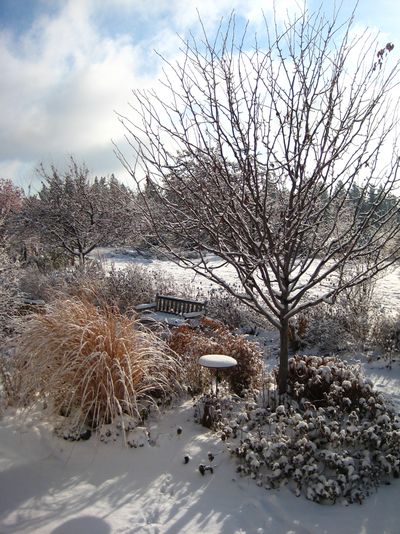In the Garden: Ornamental grasses add winter interest

It may seem cruel talking about the colder months of the year in the middle of August, but it’s an important time in the garden.
Some of the most varied and delightful plants are ornamental grasses. During spring, summer and fall, they provide color and texture. Come fall and winter, many of the grasses add interest to the garden when there often isn’t much to look at.
I don’t have a lot of ornamental grasses in my garden – yet – but three of my favorites are Northern sea oats, palm sedge and feather reed grass.
• The foliage of Northern sea oats (Chasmanthium latifolium) looks much like bamboo but certainly doesn’t have the more invasive qualities of that plant. The leaves are an attractive medium-green during the growing season but once the frosts hit, they change to copper. I love the rustling sounds it makes in the slightest breeze.
The seed heads are chevron-shaped, borne on arching branches and long-lasting. They look great in the garden throughout the fall and winter, and very nice in floral arrangements. The plants grow to about 3 feet tall and prefer part shade. Zone 3.
• Palm sedge (Carex muskingumensis) has a more dense growth habit and interesting flower heads. As soon as it frosts, the foliage changes to warm brown in color and also makes pleasant rustling sounds. It grows in full sun to part shade, needs regular watering and is deer-tolerant. Palm sedge grows 2 to 3 feet tall. Zone 4.
• Feather reed grass (Calamagrostis x acutiflora) is a real winner for any garden, in my opinion. Both Overdam, with its variegated leaves, and Karl Foerster are wonderful hybrids. The foliage and flower heads change to golden in the fall and look absolutely stunning on a sunny autumn day. Both have very upright growth habits, require regular watering and will grow 2 1/2 to 5 feet tall. For best results, plant either in full sun. Zones 4 to 5.
• Silver Feather grass (Miscanthus sinensis Silberfeder) is much taller at 4 to 7 feet and has silver stripes down the center of each leaf. As the clump gets larger over the years, it might require some support against heavy snowfall but is striking in the winter garden. The grass blooms in September, with copper-colored flowers that turn silver as winter approaches. It does best in full sun and needs regular moisture. Zone 5.
• Switch grass (Panicum virgatum) has green foliage that matures to brown when the temperatures drop. The flower panicles, borne on 3-foot-tall stems, are colored with hints of pink. Northwind features upright growth and blue-green foliage while Heavy Metal has blue leaves and pale golden panicles. For a striking contrast in the garden, try Shenandoah with its burgundy fall foliage and pink panicles that mature to tan. The plants grow 3 to 6 feet tall, prefer full sun to part shade and should be watered on a regular basis. Zone 5.
• Blue oat grass (Helictotrichon sempervirens) is a more drought-tolerant grass prized for its clumps of attractive blue foliage. It grows 2 to 3 feet tall and does best in sunny locations. The flowers are blue-green initially, then mature to golden, providing a striking contrast to the foliage. Zone 4.
Ornamental grasses rarely have insect or disease problems. The above selections should be cut back in late winter before new growth begins. Most will attract birds during the fall and winter months, bringing life to the garden when the rest of the landscape has begun its winter sleep.